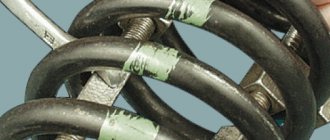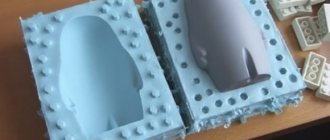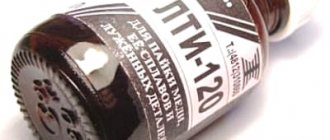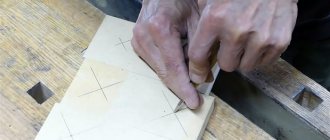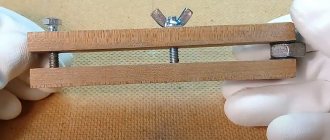Materials for production
To make a spring, you will need:
- ordinary door spring;
- gas burner or blowtorch;
- pliers;
- hand vice;
- container with machine oil;
- Bulgarian;
- bolt of the required diameter and length;
- slotted screwdriver.
Step 1. Making the blank
To make the required spring, we use a door spring, which is easy to buy in a supermarket or market.
Cut off a piece of the spring using a grinder.
To make the spring wire soft, it is necessary to anneal the steel. To do this, you need to heat it until it turns red and leave it to cool in the air. Heating a piece of spring can be done in various ways:
- Having built a microforge for the spring from pieces of vermiculite, we use a microburner.
- Using a blowtorch.
- Using a gas burner and forge.
We stop heating when the spring turns dark red (approximately 800 degrees Celsius). We leave it to cool in the air.
Step 2. Form a spring
After cooling, remove carbon deposits from the spring with a brush and unwind it.
We take a bolt with a diameter equal to the inner diameter of the spring that we want to make and, fixing the tip of the wire with a hand vice, we wind the wire tightly around it.
In the same way, springs of various shapes and purposes can be made.
For uniformity, use a slotted screwdriver to make the required distance between the turns.
After trimming, the result is a spring like this.
Step 3. Making the spring stronger and more elastic
We harden the spring, for which we heat it to a dark red color and immerse it in a vessel with machine oil.
To eliminate the fragility of the spring, we conduct a high tempering of the steel at a temperature of about 400-500 degrees Celsius, achieving a light gray tarnish color.
When this temperature is reached, stop heating and cool in air.
How to make a spring with your own hands at home
How to make a spring with your own hands [KNOW-HOW]
Hot coiling technology with quenching and tempering
Before winding, the workpiece is heated to plasticity temperature using one of the following methods
- muffle furnace;
- gas-burner;
- high frequency heating.
Next, the workpiece is supplied to the coiling equipment. The geometry is adjusted and flat ends are formed.
Heat treatment includes hardening and low-temperature tempering.
Heat treatment schedules are constructed based on the properties of the material and the dimensions of the workpiece.
Operating mode of the quenching and tempering furnace line
Next comes the control and measuring stage. Manufacturing is completed by applying anti-corrosion protection.
Five main ways to soften your car's suspension
When purchasing a car, the driver expects that he will be able to spend time in it comfortably, going to work, out of town, or just to the store for shopping. As you know, the quality of roads in Russia leaves much to be desired, but not all car manufacturers pay attention to this. Some companies specially adapt the suspension to Russian realities, making it softer so that you can comfortably overcome unevenness, potholes, off-road conditions and other sections of low-quality roads.
At the same time, a stiff suspension is also not uncommon for the Russian car market. It can often be found even on premium segment cars that are designed for fast driving. In most cases, the suspension of sports cars is rigid, this is especially true of “old Germans”. Some car manufacturers equip their models with suspension tuning systems so that drivers can adapt it to their own needs, but such functionality is provided in fairly expensive cars.
You can drive on Russian roads in a car with a rigid suspension, but the driver and passengers will feel literally every bump in the road. During long trips in cars with a rigid suspension system on bad roads, the driver gets tired very quickly, and over time his spine begins to hurt. If you purchased a car with a hard suspension, you can try to soften it. This article provides the main ways to make a car's suspension softer.
ADJUST OR REPLACE TIRES
The easiest way to soften the suspension is to work with tires that partially absorb road imperfections. There can be two options - tuning the tires or replacing them.
The first method does not require any costs from the driver, but it is less effective and more dangerous. By intentionally lowering the tire pressure, you can achieve a softer response to road irregularities on the suspension side, since less rolling will be applied to it. It is worth remembering the consequences of low tire pressure:
Deterioration of vehicle controllability;
Increased fuel consumption;
Acceleration of tire surface wear;
Increased braking distance.
While some economic losses that arise due to a forced reduction in tire pressure can be tolerated, from a safety point of view, such a solution to the problem with a rigid suspension does not look the best.
The second way is to buy softer tires. To choose them, before sending them to the store, it is recommended to read reviews of various tire models and determine which ones are the softest. If we look at the overall picture of the tire market, we can conclude that the softest tire options are presented by Michelin and Pirelli.
CUT OR REPLACE SHOCK ABSORBER SPRINGS
One of the primary roles in the operation of the suspension is played by shock absorber springs. If they are rigid and large, this increases the rolling radius of the car when overcoming obstacles; accordingly, to reduce the unpleasant sensations from the operation of a rigid suspension, they can be made smaller or a softer version can be purchased.
Specialists at a service center or in a garage can cut off part of the shock absorber springs for a fee. This will not make the suspension softer, but will somewhat reduce the rolling radius, and it will become easier to overcome obstacles (but not in all cases). At the same time, the driver runs the risk of getting a lot of problems associated with lowering the car:
Working out irregularities on cut springs can lead to rapid failure of shock absorbers;
Lowering a vehicle reduces its carrying capacity;
Overcoming potholes at high speed can lead to damage to important elements of the car: the chassis system, engine, and so on.
Another way to solve the problem of a hard car suspension is to buy softer springs. There are a variety of shock absorber springs available on the market, and salespeople at major auto stores will be able to advise on the best options for softening the suspension.
INSTALLING SOFT SHOCK ABSORBERS
Shock absorbers in a car are designed to dampen vibrations, and the softness of the suspension and its other characteristics directly depend on them. With faulty shock absorbers, a car accelerates poorly, brakes slowly, and has problems with maneuverability, smoothness and other parameters. The main task of shock absorbers is to maintain constant contact of the car wheel with the road. Some shock absorbers are made too hard, which leads to related problems.
You can make the suspension softer by replacing the shock absorbers. The most successful options for this are oil or gas-oil shock absorbers. If you want to get maximum softness of the suspension, it is better to choose a completely oil version.
REPLACING THE SUSPENSION TO PNEUMATIC
The most expensive solution to the problem is to completely replace the car suspension with a pneumatic one. Owners of cars with this type of suspension have the opportunity to adjust the driving characteristics of the car by selecting the pressure in the cushions on which the suspension rests. Its installation will not only increase the smoothness of the ride, but also, if necessary, change the ground clearance over a wide range.
The main disadvantage of switching to air suspension is the need to spend tens of thousands of rubles on modifying the car. Depending on the car model, the cost of air suspension and its installation will vary. Also among the important disadvantages it is worth noting the poor off-road performance of a car with air suspension (especially of low quality).
Air suspension
In essence, this is a completely redesigned car suspension, sometimes even working on different principles. Here pneumatic elastic cylinders can be added, which can work perfectly as an additional damper. In general, there are a huge number of buildings, but that’s not about that now.
BUT there are two problems here:
- Not all cars have them. Especially for small cars
- Cost is usually expensive. A complete set, if you take a domestic car, not China, starts from 100,000 rubles
BUT with this solution, you can achieve softness and comfort.
What affects driving performance
Factors that determine the driving characteristics of a car:
- spring stiffness and design;
- shock absorbers;
- tire size and rubber composition;
- ratio of unsprung and sprung masses.
We do not take into account the elasticity of rubber silent blocks, since the owner rarely has the opportunity to personally evaluate the difference between manufacturers of rubber products. In addition, often the main difference is the resource of silent blocks. The difference in driving performance depending on the manufacturer of silent blocks is extremely difficult to notice. The transition to polyurethane silent blocks will be striking. This type of suspension is designed for sporty driving and harsh operating conditions. If your car has polyurethane products installed, then switching to silent blocks made of regular rubber will make the car softer. Before you start tuning the chassis, carry out a comprehensive diagnosis of all suspension elements. Perhaps a too harsh, loud reaction to irregularities is a malfunction of some component, and not a design flaw. A similar effect is observed when driving on overinflated tires.
Springs
The elasticity of the springs and the amount of force required for compression depend not only on the thickness of the coils, but also on the alloy from which the elastic elements are made. Since it is extremely difficult for an ordinary buyer to find out the characteristics of the metal, you can focus on the thickness of the coil. Patterns affecting the driving characteristics of the car:
- spring design. Springs with variable coil thickness are considered the most comfortable. Such springs have a so-called comfort coil;
- The stiffer the spring, the more clearly the vibrations are transmitted to the car body. Accordingly, the thicker the coil, the greater the stiffness of the spring. A soft car suspension and hard springs are absolutely incompatible things;
- The length of the spring affects the compression stroke of the suspension. The shorter the suspension travel, the shorter the distance to the “breakdown” of the shock absorbers (occurs when the shock absorber, working off an unevenness, rests on its extreme position; at this moment an impact occurs on the bump stop). A shorter spring length leads to less suspension travel, which must be taken into account when installing sports springs (especially when cutting coils). That is why it is important to maintain a balance between the stiffness of the coils and the length of the spring.
Another important aspect is the rigidity of the material against which the spring rests. If you place a gasket made of a dense layer of rubber under the elastic element, the amount of vibrations transmitted to the body will be reduced. If you wish, you can calculate all the parameters of the springs and then make them to order. We recommend watching the video to better understand the essence of recycling elastic elements.
Shock absorbers
If the main purpose of springs is to absorb impact energy, then shock absorbers are designed to dissipate shock energy. Twin-pipe gas-oil shock absorbers cope with this most effectively. If your car is equipped with oil vibration dampers, then now you know how to make the suspension softer.
Both types of shock absorbers use oil as the working fluid. The difference is that during compression of oil models, there is no reverse force acting on the working fluid. To check, you can compress the shock absorber manually. You will see that the rod will remain compressed or will only return slightly to its previous position. In gas-oil shock absorbers, the compensation chamber is filled with an inert gas (nitrogen), so when compressed, a return force acts on the working fluid (the rod, after pressing, tends to take its previous position).
The use of gas in the design allows the wheel not to hang in the air after the suspension has worked out unevenness and will not hit the road surface. It is worth recognizing that when driving at low speeds, both types of shock absorbers work approximately the same. Another disadvantage of oil-based models is that during intensive work and overheating, air bubbles appear in the oil, which negatively affects the performance of shock absorbers and the level of comfort. It would be wrong to say that the suspension becomes softer after such tuning, but driving at high speed on bumpy roads becomes much more comfortable.
You should not install single-pipe gas-oil vibration dampers (often called gas dampers). This type of shock absorbers has greater rigidity, which will only reduce the level of comfort when overcoming bumps.
Rubber
In order to make a car more comfortable, you don’t always need to make the suspension softer. It is enough to install tires with a higher profile and soft rubber composition on the car. The profile height is the distance from the seat on the disk to the end of the tread. The parameter must be marked on the sidewall of the tire. Consider the marking 170/70 R13, in which 70 is the percentage that determines the profile height. In our case, the height is 70% of 170 (profile width) and is equal to 123 mm. How tire profile parameters affect handling and comfort:
- the higher the profile, the higher the comfort. A large rubber layer acts as an additional damping element that absorbs the main impact when driving over uneven surfaces. The suspension in combination with such tires becomes softer, but handling deteriorates;
- a wider profile in most cases means a larger contact patch. Therefore, wide tires are less likely to sink into small bumps, which increases comfort. If increased too much, a large contact patch creates a hum when driving and also increases fuel consumption;
- The composition of the rubber directly affects the shock loads transferred by the suspension parts. Soft rubber transmits less vibration to the body, but wears out much faster.
For a better understanding of all the patterns, we recommend reading the article on choosing tires for a car.
Effect of mass on suspension kinematics
The unsprung mass of a vehicle is the total weight of the elements that, when the suspension is operating, are in a movable state in relation to the body. In other words, parts of the car that move along with the suspension and some elements of the chassis. In a car, these include wheel rims, tires, brake system elements, and wheel bearings (approximately 15% of the total amount of the car, the remaining 85% is sprung weight).
To increase the smoothness of the ride, you need to either increase the sprung mass (familiar to owners of spring cars, who often load the axle for a smoother ride), or reduce the weight of the unsprung elements. Since the first option leads to an increase in fuel consumption, deterioration in dynamics and controllability, you need to focus on the unsprung mass. To make the suspension softer, it is enough to install alloy wheels, without going overboard with the width and height of the tire, as well as the size of the wheels themselves.
Prices for service stations
It happened like this: The family has a car of a French brand (an influx of trolls is expected in the comments about 3F, the French, etc.) from the 2000s. At the rear there is an independent multi-link suspension. A month ago a knock appeared and it was very strong, the sound was like hitting the bottom with a hammer from the muffler. Any independent checks on the pit did not yield results. The exhaust did not knock, everything seemed intact. My wife took the car to go on business and at the same time stop at a hundred for diagnostics. By the way, we chose the service station based on reviews, 400+ positive reviews. I’m sitting working, there’s a call, tears and the phrase “The car has broken down badly.” Knowing the whole history of the car and what had changed, I didn’t understand what could have gone wrong there. I tell my wife: “Just pay for the diagnostics, don’t sign anything and take the car.” I come home in the evening and start asking what happened there!? In response, he hands me a piece of paper with a picture of the suspension, circled parts for replacement and the amounts of spare parts and repairs. So, the unfortunate master was sentenced to 4 silent blocks of levers, 4 silent blocks of bananas, 2 shock absorbers, diagnostics and replacement of springs. Now let's look at the prices. I will write the first price of the service station and through / the one in the store. 4 silent blocks of levers 45$/20$ 4 silent blocks of bananas 40$/10$ 2 shock absorbers 130$/40$ springs 75$/45$ + work for all 200$
I usually do everything myself in the garage and very rarely go to a service station, I thought that this might be the norm? But still, the feeling got the better of him and he decided to go to another service station, by the way, to some Uncle Vasya’s garage near the house, so that he could deal with it himself and, surprisingly, he found only a broken stabilizer bushing, put a piece of hose under the bracket and the knocking disappeared. The asking price: a generous tip for Uncle Vasya, and a lesson for the wife that there is no need to rush. This post is not for the sake of hype or anything else, it’s just not clear where such a markup comes from, okay for the work, but spare parts, in general, stores sell them to you at wholesale.. Good luck to everyone and don’t rush in some things!
Source
About the diameter
How to make a spring? What wire diameter should I choose? Experts recommend using consumables with a diameter of no more than 0.2 cm. Due to the fact that such wire bends easily, it does not require preliminary heat treatment. Before winding onto the mandrel, it is unbent and carefully aligned. When choosing the diameter for the mandrel, you should proceed from the dimensions of the future spring. In other words, the internal cross-section of the product must be taken into account. Many craftsmen compensate for elastic deformations of the wire by selecting mandrels of obviously smaller diameter. When working with wire thicker than 0.2 cm, difficulties often arise when winding it onto the mandrel. In this case, you will have to perform preliminary annealing.
Features of the technology
The technological process for manufacturing elastic elements depends on the technical requirements for the design. Making a spring is not as easy as an ordinary part, which should not have special elastic properties. This requires special equipment and equipment.
Winding of springs with a round coil section is carried out using the following methods:
- Cold. Suitable for small and medium sizes (wire diameter up to 8 mm).
- Hot. For large diameters.
Spring coiling technology
After winding, the elastic elements are subjected to various types of heat treatment. During this process, the product acquires the specified properties.
Where should I start?
Experts recommend using wire from an old spring whose diameter does not suit the owner. The craftsman will only have to align it and wind it onto a mandrel with a cross-section of the required size. To do this, the wire must be absolutely straight. It will be much more plastic if it is processed in a special oven. If you don’t have one, any other device that can be heated with firewood will do. According to experienced craftsmen, birch provides sufficient heat for firing. After lighting the stove, you need to wait for the wood to burn in it. Only coals should remain. You should put the old spring in them. If the product is hot enough, it will turn red. Now the spring can be moved to the side so that it cools in the air. After this procedure, the metal will become plastic and easy to work with.
Requirements for wire and its diameter
Steel wire for the manufacture of a spring, which will subsequently be hardened, must meet the requirements specified in GOST 14963-78. According to the document, it is classified according to the following criteria:
- winding method (cold and hot);
- method of surface finishing (without finishing and with finishing);
- manufacturing accuracy (normal and increased);
- class of mechanical properties (general and critical use);
- diameter (from 0.5 to 14 mm);
- type of delivery (in rods or coils).
At industrial enterprises, springs are made from wire with a diameter of no more than 16 mm using the cold winding method, and up to 80 mm using the hot method. In production, they are wound using a rotating mandrel, feed rollers and one or two stop pins.
Products are made from wire grades 51ХВА, 70С3А, 65С2ВА, 60С2А, 65Г, 60ХВА with a ground, polished surface or without grinding and polishing. Based on this characteristic and the manufacturing method, the wire is produced in rods or coils of the following groups:
- A, B, C, D, E – with special finishing;
- N - without finishing.
The wire symbol in the technical documentation and on accompanying tags consists of numbers and letters:
- 1 – steel grade;
- 2 – surface finishing method;
- 3 – manufacturing accuracy;
- 4 — class of mechanical accuracy;
- 5 - winding method;
- 6 - diameter in mm;
- 7 - designation of the standard.
For example, a wire with a polished surface made of high-precision class I steel 60C2A for hot coil springs with a diameter of 2.0 mm will have the following designation:
60S2A – A – P – I – GN – 2.0 GOST 14963-78
The state standard specifies permissible maximum deviations, out-of-roundness and the inadmissibility of certain types of defects, as well as methods of packaging and transportation.
How to make a spring?
After waiting until the old product has cooled down sufficiently, they begin to unwind it. Absolutely straight wire should be wound onto the mandrel. For those who do not know how to make a spring, experts recommend placing the coils close together. At this stage, the master will have to make physical effort. The mandrel is clamped in a bench vice.
The work will be much easier if you use pliers. Judging by the reviews of experienced craftsmen, very often beginners have difficulty selecting the size of the mandrel. It is possible that you will have to work not with one mandrel, but with several with different sections. The diameter for a homemade spring in this case is selected experimentally.
Hardening of the product
For those who are interested in how to make a spring themselves, experienced craftsmen also advise paying attention to its hardening. This procedure consists of heat treatment of the product in order to give it the required elasticity.
A spring that has undergone hardening becomes much harder and more durable compared to its original state. Heat treatment is performed in special furnaces at temperatures from 830 to 870 degrees. You can also cope with this work at home using a regular gas burner. Since there are usually no temperature sensors in such devices, the home craftsman will have to control the process visually. The color of the item being heated can be used as a guide. When heated to 800 degrees, the metal turns cherry red. This means that it is too early to remove the product from the oven. If the spring is hot enough (870 degrees), it will turn light red. Now it should be cooled. Transformer or spindle oil is suitable for this purpose. In special factory thermal furnaces, metals are heated to 1050 degrees. Products at this temperature regime acquire orange shades.
Cold coiling technology without hardening
First you need to do preparatory operations. Before a workpiece is wound from wire, it is subjected to a patenting procedure. It consists in heating the material to the plasticity temperature. This operation prepares the wire for the upcoming change in shape.
During the winding operation the following parameters must be maintained:
- External diameter of the product (for some parts the internal diameter is standardized).
- Number of turns.
- Winding pitch.
- The total length of the part, taking into account subsequent operations.
- Compliance with the geometry of the end turns.
Cold coiling without tempering
Next, the end turns are ground down to a flat state. This must be done to ensure high-quality support for other structural parts, to prevent their destruction and the spring from slipping out.
The next stage of the technological process is heat treatment. Cold coiling of springs involves only tempering at low temperatures. It allows you to increase elasticity and relieve mechanical stresses that arise during winding.
It is extremely important to strictly adhere to the design heat treatment schedule, carefully controlling temperature and holding time.
After heat treatment, it is necessary to carry out test and control operations.
Further, if necessary, protective coatings can be applied to prevent corrosion. If they were applied by galvanic method, the products are reheated to reduce the hydrogen content in the surface layer.
Final stage
After the hardening procedure, the spring should be compressed and left in this position for two days. Then, using a sharpening machine, its ends are processed. This will give the handicraft the required size. After completing all of the above steps, the spring is considered ready for use. According to experts, homemade products cannot be compared with similar factory-made products.
However, non-standard springs are widely used in various mechanisms. If they are used in a gentle manner, the springs will last quite a long time.
How to make a mattress firmer
Making a mattress harder is often not a whim, but a necessity. The elasticity of the product determines how comfortable it will be to sleep on it, and therefore the health of your back and your overall well-being.
Oh, if only the Princess and the Pea knew that she didn’t get enough sleep not because there were only ten feather beds, and not at all because of a tiny surprise. The bed was just too soft! In the days of princesses they still believed that the softer the bed, the better it was. But now we know that the key to a healthy spine is sleeping on a hard surface.
No matter how you test the chosen model before purchasing, you may not be able to immediately understand whether it is right for you. Whether a mattress is hard enough usually becomes clear after a few weeks of use. And if the “softness” of the new bed turns out to be not very comfortable for the spine after a week, changing it is somehow out of the question. Then the question arises: how to increase the rigidity of the mattress?
Methods for restoring springs
Most often, spring fatigue is discovered completely by accident, for example, when the car is loaded more than usual, and it literally begins to cling to the road with its bottom.
There are several solutions to this problem. Naturally, the easiest way is to install new springs; they will last longer and cause fewer problems, but this method is not the cheapest, so more and more often car owners are trying to revive old springs.
There are several ways to restore springs: electromechanical and thermomechanical, which we will tell you about today.
Let’s immediately make a reservation that the process of restoring springs is not the easiest and most pleasant; it requires a lot of strength, strong patience and special equipment, among which we should note a vice, an electric transformer, a lathe and a small oil bath with AC-8 oil.
Mattress pads for firmness
There is no need to figure out what to put on top of the bed to increase the rigidity of the sleeping place. There are special linings for this, also known as toppers.
The topper is a separate thin mattress that is secured to the main model using elastic bands or ties (ribbons are much more convenient in everyday life). It can make the sleeping surface harder, correct unevenness, and increase comfort. In general, it provides orthopedic support for the entire body.
Most toppers are made from natural coconut fiber or holofiber, sewn into a cotton or cotton jacquard cover. They come in thicknesses from 2 to 12 centimeters; the higher the thickness, the harder your sleeping place can be. For example, for a soft mattress you will need a topper with a height of about 6-7 centimeters, and to tighten a medium-level mattress, a model with a thickness of 3-4 cm will be enough.
Mattress covers
They should not be confused with toppers. A mattress cover is a special protective cover against dust, moisture, and various contaminants. Due to their small thickness, mattress covers cannot greatly change the hardness of the sleeping area.
The cheapest topper consists of a sheet of foam rubber and a jacquard cover. This type of bed cover will not save you. Pure polyurethane foam, holofiber or memory foam are used to soften mattresses, which is exactly the opposite of our purpose.
Should it be tougher?
If you're not sure whether you need a firmer mattress, check yourself with our checklist. You definitely need to increase your elasticity if:
- Do you prefer to sleep on your back or stomach?
- You are overweight
- You are arranging a bed for a child or teenager
- Do you play a lot of sports?
- Do you have problems with your spine?
- Do you want to improve your posture?
- You lead a sedentary lifestyle.
Yes, you were right, almost everyone actually has one or another indication for sleeping on a hard mattress. And although there are people who sleep more comfortably on a soft one, from the point of view of back health, hard models are much more useful.
What should you pay attention to?
Many people buy toppers to improve the sleeping properties of their sofa. They are usually rolled up for the day, turning the sofa into a seating area. Remember that coir models cannot be rolled. Thin polyurethane foam mattresses can break at the bends, just like products made from natural latex. If the ability to fold and put away your topper is important to you, choose models made from polyester or memory foam.
The removable cover on the topper will make caring for the bed much easier, because it can be washed.
Light wheels
There is also some truth here. You can work with wheels, just like with tires. Again, reduce the diameter of the rim (if you install tires with a larger profile).
And you can also reduce the weight of the disk, and accordingly you can reduce the sprung mass, how well this has a beneficial effect on comfort, not critical, but still.
For example, instead of a heavy stamped wheel, you can put a lightweight forged disk. Sometimes casting is lighter, but you need to look for it; some alloy wheels, on the contrary, are heavier.
With this approach, softness will increase a little, but again you shouldn’t expect miracles.
How to make a mattress harder with your own hands.
Some mattresses come with removable covers. If your model allows it, unzip the case and take a look: chances are you can swap the layers, putting a layer of coir on top and putting the soft foam material underneath. You can also add a coconut fiber mat inside the cover.
If you want to do without forced purchases and increase the rigidity of the mattress with your own hands, then you will have to try your hand at making mattresses at home. Nowadays, you can easily purchase foam rubber or pressed coconut coir in a store, so you only need to decide on the desired thickness of the topper and make a cover for it.
Remember that a foam sheet will last 5-6 years, while coir will last 10-25. And the mattress itself needs to be changed every 8-10 years.
